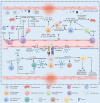Bioactive peptides and proteins for tissue repair: microenvironment modulation, rational delivery, and clinical potential
- PMID: 39639374
- PMCID: PMC11619216
- DOI: 10.1186/s40779-024-00576-x
Bioactive peptides and proteins for tissue repair: microenvironment modulation, rational delivery, and clinical potential
Abstract
Bioactive peptides and proteins (BAPPs) are promising therapeutic agents for tissue repair with considerable advantages, including multifunctionality, specificity, biocompatibility, and biodegradability. However, the high complexity of tissue microenvironments and their inherent deficiencies such as short half-live and susceptibility to enzymatic degradation, adversely affect their therapeutic efficacy and clinical applications. Investigating the fundamental mechanisms by which BAPPs modulate the microenvironment and developing rational delivery strategies are essential for optimizing their administration in distinct tissue repairs and facilitating clinical translation. This review initially focuses on the mechanisms through which BAPPs influence the microenvironment for tissue repair via reactive oxygen species, blood and lymphatic vessels, immune cells, and repair cells. Then, a variety of delivery platforms, including scaffolds and hydrogels, electrospun fibers, surface coatings, assisted particles, nanotubes, two-dimensional nanomaterials, and nanoparticles engineered cells, are summarized to incorporate BAPPs for effective tissue repair, modification strategies aimed at enhancing loading efficiencies and release kinetics are also reviewed. Additionally, the delivery of BAPPs can be precisely regulated by endogenous stimuli (glucose, reactive oxygen species, enzymes, pH) or exogenous stimuli (ultrasound, heat, light, magnetic field, and electric field) to achieve on-demand release tailored for specific tissue repair needs. Furthermore, this review focuses on the clinical potential of BAPPs in facilitating tissue repair across various types, including bone, cartilage, intervertebral discs, muscle, tendons, periodontal tissues, skin, myocardium, nervous system (encompassing brain, spinal cord, and peripheral nerve), endometrium, as well as ear and ocular tissue. Finally, current challenges and prospects are discussed.
Keywords: Bioactive peptides and proteins (BAPPs); Clinical potential; Delivery strategies; Growth factors; Tissue regeneration.
© 2024. The Author(s).
Conflict of interest statement
Declarations. Ethics approval and consent to participate: Not applicable. Consent for publication: Not applicable. Competing interests: The authors declare that they have no competing interests.
Figures









References
-
- Shan BH, Wu FG. Hydrogel-based growth factor delivery platforms: strategies and recent advances. Adv Mater. 2024;36(5):e2210707. - PubMed
-
- Wang Y, Hao Z, Li B, Tang J, Zhang Z, Wang Z, et al. A novel octa-arginine-modified injectable self-assembling peptide hydrogel for multidrug-resistant cancer therapy. Mater Des. 2024;237:112564.
Publication types
MeSH terms
Substances
Grants and funding
- 82372405/the National Natural Science Foundation of China
- 81871752/the National Natural Science Foundation of China
- 2022BCA052/Hebei Provincial Key Research Projects
- 2024020702030105/the Key Research and Development Program of Wuhan City
- 2042023kf0199/the Fundamental Research Funds for the Central Universities
LinkOut - more resources
Full Text Sources

